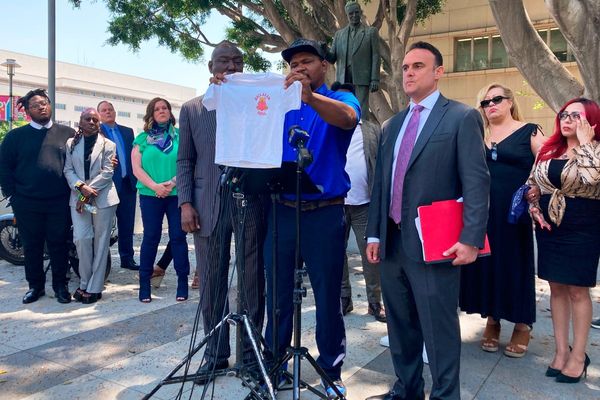
Just nine years after Augusta Institute’s founding in Georgia, a bloody massacre took place directly across the Savannah River in Hamburg, South Carolina. Since 1867, the leaders of the institute – a small, all-Black seminary – had endured various attacks by local white citizens for educating Black students following the civil war. But the Hamburg massacre, which resulted in the execution of six Black men ahead of one of the most contentious presidential elections in US history, epitomized the extent of post-emancipation violence against Black advancement. Designed to terrorize newly freed citizens, the massacre set the standard for how Black communities could be punished for amassing political and institutional power.
After learning firsthand that Black political mobility and Black education stoked white resentment and violence, the seminary men fled to Atlanta. They strategically broke new ground for their institution on former Union army barracks; its location on a hill at the city’s highest elevation point gave them a vantage of any attempts upon it. Two decades later, the school was renamed Morehouse College, at the time one of the nation’s only colleges for Black men. A few years after that, Spelman College, a college for Black women, relocated less than a mile away from Morehouse, to achieve safety in numbers.
Since their foundings, historically Black colleges and universities (HBCUs) have prioritized sanctuary for Black people both within and outside their gates. Much of the geography, design and mission of these schools was shaped by the Reconstruction era’s reign of terror. I was reminded of this legacy on 26 August, when a gunman in Jacksonville, Florida, armed himself with an AR-15, tactical gear and a mask in the parking lot of Edward Waters University – the city’s sole HBCU – before heading to a nearby Dollar General and killing three Black people. Although the 21-year-old shooter didn’t attack the university, his presence at the school gestured toward the long history of terrorism against Black people and their institutions.
In response to the shooting, Florida governor Ron DeSantis pledged $100,000 to the victims’ families, and an additional $1m to augment security at Edward Waters. Previously, DeSantis has lauded his state funding for HBCUs, of which Edward Waters received $6.4m for the 2020-2021 school year. “HBCUs play an important role in Florida’s educational fabric and continue to be trailblazers for innovation, talent and leadership,” the governor said in a 2020 address.
To many Black Floridians, however, those gestures have little meaning when DeSantis’s administration fostered the political climate, policies and ideologies that rendered the state’s oldest HBCU and a nearby business vulnerable to a white supremacist shooter. Immediately after the governor’s razor-thin 2019 defeat of his Black Democratic opponent Andrew Gillum (who remarked that racists believed DeSantis was one of them), DeSantis gutted laws that expanded Black voter protections and instituted an election police force that later arrested Black voters at gunpoint on voter fraud charges. This year, the governor launched a widely criticized assault on the teaching of slavery, segregation and accurate US history in K-12 curricula. With the stroke of a pen, he slashed budgets for programs advocating for gun violence prevention and Black history education – programs that could keep Edward Waters both physically safe and institutionally significant.
Like the Hamburg massacre and the fury that incited it, physical white violence against Black people is almost always preceded by the political white violence against them. Although Florida was once an early 20th-century incubator for enclaves of Black prosperity, much of the state’s Black economic progress was squashed by Jim Crow legislation and a century of massacres and lynchings. Live Oak, Florida, where Edward Waters was founded in 1866, is notorious for the 1944 lynching of Willie James Howard, a 15-year-old Black staffer at an integrated dime store, who was kidnapped by three white men because he sent a love note to one of their daughters. One of the country’s most heinous attacks on Black teachers occurred in Brevard county, Florida, when Harriette and Harry Moore, husband-and-wife civil rights activists who organized within the NAACP for Black teacher pay equity, were assassinated in the 1951 Christmas Day bombing of their home. Only 150 miles from Jacksonville, the Ocoee massacre, a retaliation against Black organized efforts to vote, resulted in the ethnic cleansing of the town’s Black population, lasting for more than 50 years.
While it is uncertain whether Edward Waters was ever targeted directly by physical white violence, it has long been plagued by policies of economic racism. During the Jim Crow era – long before anything called an “anti-woke” bill was ever imagined – Florida’s legislature limited funding for its four HBCUs to create and sustain a two-tiered, segregated higher ed system. Edward Waters, like other public and independent Black colleges across the south, was manipulated by politicians who ostensibly supported HBCUs, but only because of their refusal to desegregate white campuses. Those policies ensured that HBCUs got the short end of the stick while redirecting state resources towards the massive growth and expansion of white colleges. In June of this year, a federal judge ruled that six Florida A&M University students could move forward with a lawsuit alleging that the state’s systemic undercutting of the HBCU’s funding stems from de jure segregationist state policies that have been in place since before the civil rights movement.
White terrorism was never an effort by individual white people to ambush individual African Americans. Rather, it’s an instrument to keep Black institutions, communities and people under the heel of subjugation – just as happened in Hamburg, where the vestiges of a once-Black town have been replaced today by perfectly manicured private golf courses. Black colleges represent a threat that white supremacists seek to thwart: political, economic and social competition from people who emerged from 250 years of slavery as politicians, intellectuals, freedom fighters and self-sufficient community members. Edward Waters narrowly escaped what could have been its greatest tragedy, but without an end to the anti-Black policies that rendered it vulnerable in the first place, it remains in a vicious fight for its political survival.
• This article was amended on 4 September 2023 because an earlier version omitted to note that HBCUs stands for historically Black colleges and universities.







